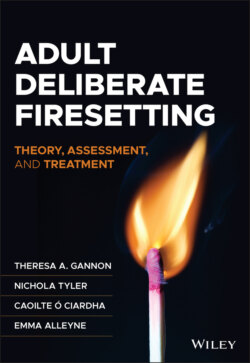Читать книгу Adult Deliberate Firesetting - Theresa A. Gannon - Страница 19
2 Key Characteristics and Clinical Features of Individuals Who Set Deliberate Fires
ОглавлениеDescribing the characteristics of who sets fires will not be particularly informative unless we begin by noting two important considerations. First, there is no one personality or psychopathology that defines individuals who set fires. These individuals are heterogeneous in their characteristics, offending histories, and motives for setting fires. Second, consideration of the factors that differentiate people who engage in criminal firesetting (i.e., apprehended or non-apprehended) from people in the general population who have not engaged in criminal behaviour differs from consideration of the factors that differentiate people who have engaged in criminal firesetting from other justice-involved individuals who have not set fires. This distinction is important. If people who set fires are indistinguishable—psychologically speaking—from the general population, then practitioners have no treatment targets to address in prevention or treatment initiatives. If individuals apprehended for firesetting are indistinguishable from other justice-involved individuals, then treatments need not be tailored for firesetting. This chapter examines the key demographic, developmental, psychopathological, and psychological features of individuals who have set fires. A key aim of this chapter is to highlight (1) the key clinical features that appear to differentiate those who have set deliberate fires from the wider population and (2) the key clinical features that differentiate individuals apprehended for firesetting from other justice-involved individuals.
When considering the characteristics of any offending population, it is worth considering why we are interested in these characteristics. First, establishing what sets our focal population apart from the rest of the population may provide indirect evidence of the causal chains that have led to the offending behaviour. The observation of differences between groups provides a starting point for hypothesising about the causal relationships between background or psychological factors and offending behaviours like firesetting. Second, examining group differences in characteristics helps us to determine which factors are statistically related to increased risk of offending or re-offending and thus improves decisions about the prioritisation of individuals for treatment as well as public protection decisions about release and supervision. A third reason why we are interested in the characteristics of offending populations is to determine which factors may be targets for treatment.
A key consideration when examining and presenting information on the characteristics of adults who set fires is the quality of evidence available. The most useful evidence for the characteristics of this population would come from high-quality sources, ideally cohort studies, representative large sample studies, well-powered studies with matched comparison groups, or meta-analyses. Unfortunately, these types of sources are rare in the study of adult firesetting due to the relative recency of sustained research on the topic.
